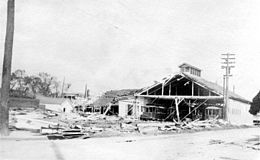1915 New Orleans hurricane
| Category 4 major hurricane (SSHWS/NWS) | |

Smashed streetcar barn, New Orleans
|
|
| Formed | September 21, 1915 |
|---|---|
| Dissipated | October 1, 1915 |
| Highest winds |
1-minute sustained: 145 mph (230 km/h) |
| Lowest pressure | 931 mbar (hPa); 27.49 inHg |
| Fatalities | 275-279 |
| Damage | $13 million (1915 USD) |
| Areas affected | Trinidad and Tobago, Windward Islands, Leeward Antilles, Venezuela, Colombia, Jamaica, Honduras, Cayman Islands, Cuba, Yucatán Peninsula, Louisiana, Mississippi, Alabama, Tennessee, Kentucky, West Virginia, Pennsylvania |
| Part of the 1915 Atlantic hurricane season | |
The New Orleans Hurricane of 1915 was an intense Category 4 hurricane that made landfall near Grand Isle, Louisiana during the 1915 Atlantic hurricane season. The storm formed in late September were it moved westward and peaked in intensity of 145 mph (230 km/h) where it made landfall on September 29. The hurricane killed 275 people and caused $13 million (1915 US dollars) in damage.
The storm was first reported near the Lesser Antilles between Puerto Rico and South America. In the Caribbean, it strengthened to a 145 mph (230 km/h) Category 4 hurricane on September 25. As the hurricane moved closer to the Gulf Coast, hurricane warnings were put up from Florida to Louisiana. The storm made landfall near Grand Isle, Louisiana on September 29 as a strong Category 4 hurricane with 145 mph (230 km/h) sustained winds. The storm then moved north and weakened into a tropical storm as it crossed into Mississippi, Alabama and Tennessee. The storm became extratropical as it moved north.
In New Orleans winds of 50 miles per hour (80 km/h) reached the city at 7am, climbing to 60 miles (97 km) an hour over the next 5 hours. Hurricane conditions were experienced from the afternoon into the night, with steady winds of 102 mph (164 km/h) and gusts up to 130 mph (210 km/h). There were reports of damage in New Orleans, with roofs blown off buildings and the Presbytère on Jackson Square losing its cupola. The clock on St. Louis Cathedral stopped at 5:50pm, the height of the storm. The hurricane damaged the Times-Picayune building, hampering newspaper production. More church steeples in the city were blown down or significantly damaged than remained intact.
...
Wikipedia
